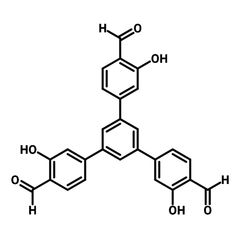1,3,5-Tris(4-formyl-3-hydroxyphenyl)benzene
CAS Number 2244985-34-8
Carbaldehyde Monomers, Chemistry Building Blocks, COF Ligands, Materials, Porous Organic Frameworks
Covalent organic frameworks (COFs) trihydroxyphenylbenzene ligand
serves as a building block to synthesize COFs for applications in porous materials and sensors
1,3,5-Tris(4-formyl-3-hydroxyphenyl)benzene (CAS number 2244985-34-8) is composed of three salicylaldehydes attached to a benzene ring. The salicylaldehyde, also known as 2-hydroxybenzaldehyde, readily undergoes reactions with amine and hydrazine derivatives, resulting in the formation of a hydroxy-imine moiety. This hydroxy-imine moiety can coordinate with a metal centre, leading to the production of metal-COF complexes. Furthermore, the hydroxy-imine moiety exhibits an excited-state intramolecular proton transfer (ESIPT) during photoirradiation, producing remarkable luminescence. When anions such as fluorides are introduced to the COFs, the luminescence is quenched due to the interaction between the anions and the hydroxyl group, thereby switching off the ESIPT process. Consequently, the COFs synthesized from 1,3,5-tris(4-formyl-3-hydroxyphenyl)benzene can be effectively employed in anion sensors.
The COFs based on 1,3,5-tris(4-formyl-3-hydroxyphenyl)benzene are proposed as a self-made solid-phase extraction for the analysis of α2- and β2-ARAs residue in milk. This is attributed to the abundant hydroxy groups in the COF networks and their high surface area of 597 m2/g.
Duo functionality
Enabling post-functionalisation
High Purity
>98% Purity
Worldwide shipping
Quick and reliable shipping
MOF and COF ligands
Aldehyde and hydroxy ligand for cross-linked COF networks
General Information
| CAS Number | 2244985-34-8 |
| Chemical Formula | C27H18O6 |
| Full Name | 5'-(4-Formyl-3-hydroxyphenyl)-3,3''-dihydroxy-[1,1':3',1''-terphenyl]-4,4''-dicarbaldehyde |
| Molecular Weight | 438.43 g/mol |
| Synonyms | TFHB |
| Classification / Family | COFs, Intermolecular proton transfers, Anions sensing, Metal-COF complexes |
Chemical Structure

Product Details
| Purity | 98% |
| Melting Point | N/A |
| Appearance | Off-white powder |
MSDS Documentation
 1,3,5-Tris(4-formyl-3-hydroxyphenyl)benzene MSDS Sheet
1,3,5-Tris(4-formyl-3-hydroxyphenyl)benzene MSDS Sheet
Literature and Reviews
- A new hydrazone linkage-based covalent organic framework for ratiometric fluorescent probe detection of hypochlorite, J. Xiu et al., Spectrochim. Acta A, 306, 123577 (2023); DOI: 10.1016/j.saa.2023.123577.
- Excited-state intramolecular proton transfer based covalent organic framework for fluorescence anions sensing, Z. Wang et al., New J. Chem., 46, 14122–14126 (2022); DOI: 10.1039/D2NJ02032G.
- Excellent crystallinity and stability covalent-organic frameworks with high emission and anions sensing, J. Wan et al., Macromol. Rapid Commun., 43 (20), 2200393 (2022); DOI: 10.1002/marc.202200393.
- Hydroxylated hierarchical flower-like COF for solid‐phase2 extraction of α2- and β2- adrenergic receptor agonists in milk, G. Xu et al., SSRN (2023), DOI: 10.2139/ssrn.4614089.
